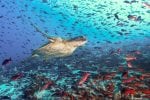The Galapagos is like a “living laboratory” – here we can observe how nature evolves and evolution works. Charles Darwin visited the Galapagos Islands in the fall of 1835, and the weeks he spent here proved to be extremely important to his further research, theories, and results. The place still offers a unique opportunity to explore a pristine and absolutely stunning ecosystem. Darwin noted, for example, that although all islands shared similar volcanic living conditions, and basically had the same environment and climate, each island had its own, unique composition of species. A unique place on the planet. This trip also brings you to Las Tanusas, with luxury-relaxing-dream vacation on the program.
Contact form

Ecorating: 3.5
This product meets our requirements for Ecorating, a product that is good for humans and the environment.
Does my trip make a difference?
Read more
This product meets our requirements for Ecorating, a product that is good for humans and the environment.
Sample Itinerary
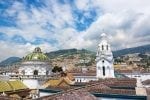
Welcome to Ecuador! After a long journey you will be met at the airport and driven to your hotel (private transfer). Rest before the adventure begins.
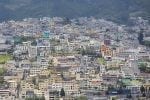
After breakfast, we take a city tour of Quito, where we pass the government palace, the heart of the city Plaza de la Independencia, the beautiful Jesuit church La Compania and other important places and buildings in the city, such as. the convent of San Francisco, built just in the period when Quito began to become a city – ie in the middle of the 16th century. We also pass the La Ronda area, with exciting shops, local artisans and a very special, colonial atmosphere. At the end of our trip, we head up to Panecillo, where in addition to the view we can also see the famous statue “Virgen de Quito” Ecuador’s unique climate close to the equator provides perfect conditions for growing the world’s finest cocoa – Cacao Arriba. Cocoa has been a part of local gastronomy for over 5,000 years. When the Spanish explorers and conquerors came here, they loved the taste of cocoa so much that they called it “the food of God.” We visit the company Republica del Cacos, which began a journey over ten years ago, when they started their mission to produce locally produced chocolate of the finest quality – but in a sustainable way. Our chocolate experience begins with a guided journey through history and Ecuadorian cocoa to end with a chocolate tasting.

After breakfast, the trip goes to the airport – we have to fly to the Galapagos Islands. Arrival at San Cristobal Airport and transfer to the ship Natural Paradise – a newly built luxury yacht for travelers who really want to enjoy life and the amazing surroundings. This relatively intimate ship can carry up to 16 passengers on board. To make exploring the underwater world of the archipelago easier, snorkeling equipment, wetsuits and underwater cameras are available. After a day on and in the water, relax with a cocktail from the bar on the main deck, or soak up the sun on the spacious sun terrace, which has sun loungers, a hot tub and an al fresco dining area.
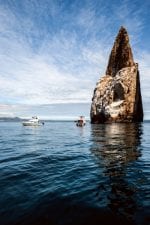
Kicker Rock: this impressive rock formation is located a few hours from the west bank of San Cristobal. The rock formation stands proudly vertically hundreds of meters above sea level. An impressive sight. With the cliff as a background, we take a break with good time to snorkel, dive or take a canoe trip. In the water here live tropical fish species, different kinds of sharks, turtles, manta rays and much more. There is plenty of life here, also in the air with a throng of birds. This day does not require any special knowledge – you decide the level of how much / little you want to experience.
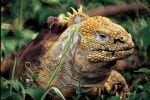
In the morning we head to North Seymour Island, where, among other things, sea lions, the beautiful blue-footed sole, impressive frigatebirds and many other unique species of animals and birds live. The island was formed by a series of lava-containing sediment layers, which are lifted slowly from the seabed by means of tectonic activity. The island is characterized by its arid climate. Here you can also snorkel or dive from the ship. The hike on North Seymour Island lasts between two and three hours, so good hiking shoes are important.
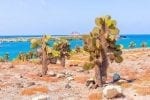
The morning is for free use and in the afternoon we continue towards South Plaza Island This small island with steep cliffs was formed by lava and is now home to lots of Opuntia cacti and a giant colony of sea lions. You will also most likely spot the beautiful red iguana. On the island also grows the characteristic plant is Sesuvium. During the period when it rains here, the plant has a greenish to yellowish tone, but in the dry season (from June to January) it changes color to pink. Even today we walk between two to three hours.

Morning excursion to Rabida Island and Bartholomew Island. Rabida Island (Jervis) is one of the most colorful and varied islands in the archipelago and a great place for snorkeling. The island’s famous sandy beach and great views are just some of the experiences that await. The island is a paradise for ornithologists: here are finches, sparrows, hawks and brown pelicans. We also see penguins, sea lions and iguanas. Today’s hike is not that long, approx. one hour.
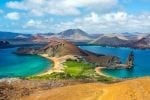
Today we experience Bartholomew Island – a volcanic island with the most beautiful red, orange, black and green volcanic formations. The island also has one of the Galapagos Islands’ most famous rock formations: Pinnacle Rock. A staircase leads to the top of the volcano where a magnificent view awaits. The beach is perfect for snorkeling and maybe we spot Galapagos penguins too. The landscape here on the island resembles a lunar landscape in some places, and nature offers exciting plants and cacti. Possibility of snorkeling. Today’s hike is approx. two hours. If you choose to go up to the top of the volcano, 375 relatively steep steps await.
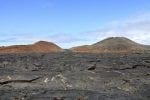
Arrival at Sullivan Bay, where we land at a coral beach and a lava field that stretches as far as the eye can see. The last eruption of the volcano was for approx. 100 years ago and it is a fascinating experience to see how life has returned, how plants quietly spread and survive in this harsh environment. Enjoy the tranquility, the beautiful coral beach and the clean air. Opportunity for hiking, swimming, snorkeling or diving. Good hiking shoes are essential, the lava rocks can be sharp.

Dragon Hill is located on Santa Cruz Island and is one of the newer places where tourists can come to the Galapagos Islands. Here we go for a slightly longer walk, partly along a beach and up to a lookout platform. Below us we see the lagoon, where flamingos peacefully search for food in the shallow water. Today’s hike is not that long but can be demanding: the path can be muddy, and here there are also a lot of rocks and in some places uneven ground.
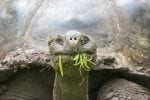
Santa Cruz Highlands is an area that is completely different from what we have experienced before: a deep green contrast to the dry, lower islands. The area is only accessible by bus from Puerto Ayora, and the dominant vegetation in the highlands is the forest of Scalesia trees, which stands for the lush green color. The lava tunnels, which are over half a kilometer long, are underground, and walking through them is a unique, almost surreal experience. During the day we almost certainly meet turtles, which slowly move through nature. Opportunity to visit a center where you study and help turtles. A long walk today, but on easy trails. Later we go down to the harbor to take the ferry to Isla Isabela and visit a breeding center where we work to improve the conditions and distribution of the Galapagos turtles. These large animals can grow up to 1.3 meters long and weigh up to 400 kg. Expert guides explain the breeding process and how the release back to nature works. Arrive and check in at Isamar Hotel.
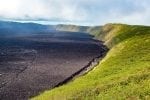
Isabela Island – another wonderful day of hiking. Volcanic eruptions created all the islands in the Galapagos and you will get close to this geological process as we explore Isabela, one of the youngest and most volcanically active islands in the area. We have all day to explore the Isabela Highlands and we start by hiking up to the crater of the massive Sierra Negra volcano and then on to the volcano Chico. This fascinating hike usually begins with a special morning mist in the air and often rain. Despite the rain, we can see Galapagos hawks, finches, sparrows and owls along the way. When we reach the edge of the Sierra Negra crater, the second largest in the world after Ngorongoro in Tanzania, we get our reward. The crater is so large and so impressive that pictures can not convey the feeling you get at the edge.
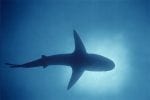
Today we take a trip to the small islands of Tintoreras. Here we can see sharks, sea lions, turtles, penguins and devil rays. The opportunity to snorkel in the bay. In the afternoon we cycle through different wetlands where we can see colonies of iguanas and a variety of types of mangrove forest. Finally, we end up at the “Wall of Tears”, which was built by prisoners from the mainland during approx. 15 years from the mid-40s. The wall had no real purpose, but was only a way to keep the prisoners going with something. On this trip we experience great views, see lots of birds and maybe even a giant turtle.

Today we say goodbye to the island of Isabela and travel early by ferry to Puerto Ayora and Baltra to fly to Guayaquil, Ecuador’s largest city with over 2 million inhabitants. Overnight in Guayaquil.
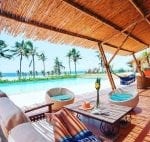
Today we continue with private transfer to Puerto Cayo, a sleepy fishing village on the Pacific Ocean. Not much happens here, and on the beach you can eat fantastic seafood dinners at one of the local restaurants. This is pure relaxation after the hectic days in the Galapagos Islands. You stay at Las Tanusas Retreat & Spa. Tanusas consists of a main house and 5 villas, and the goal of the company is to offer sustainable luxury and an oasis. The hotel is close to the small communities of Puerto Cayo, Cantagallo and Puerto La Boca. The hotel will be in harmony with its surroundings and nature, and you will feel this e.g. when visiting the hotel’s restaurant BocaValdivia. Here we work with good ingredients from the local community and with respect for the nature that has given us this particular meal. The hotel also has a surfable spa, yoga classes and more. Pure enjoyment of life in the most beautiful setting.
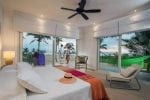
Accommodation in Master Ocean room including full board.
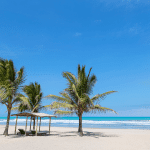
At Las Tanusas there is a wonderful beach to enjoy. If you do not want to swim, there are plenty of activities: snorkeling, surfing, yoga, cooking classes, bike rides and various trips. Head over to the Parochi Forest to say hello to monkeys, sloths, foxes, ozelots and lots of different bird species.
Trip details
Ecorating: 3.5
When can you travel?All year
Airport: Quito International Airport Mariscal Sucre (UIO) or Guyaquil.
Travel length: 15 nights
The price includes: International flight, accommodation and meals as in the program, English-speaking guide, various transfers. Speedboat ride, snorkeling equipment, activities and excursions according to the program, domestic flights to and from the Galapagos Islands
Price does not include: Admission to Galapagos National Park (USD 100 per adult, children half price) tourist taxes USD 20 / person , drinks, laundry, dinner on Isla Isabela, and extra activities.
Good to know about the Galapagos and Ecuador:
Travel Ethics: You’re visiting one of the most unique places on the planet. It is strictly forbidden to throw with waste, affect or destroy flora and fauna. Nothing should be taken to the Galapagos Islands that could affect ecosystems, and nothing should leave the islands. Feel free to bring small banknotes in USD to tip.
Visa: most citizens do not need a visa to travel to Ecuador and the Galapagos Islands. However, the passport must have a minimum of two blank pages, and be valid for a minimum of six months after returning home.
Time zone: GMT -5
Vaccination: Read more about which vaccinations you have need here
Packaging: Sunglasses, sun hat, sunscreen, snorkel-friendly swimwear and good hiking shoes / hiking boots.
Local Currency: USD
Weather: San Cristóbal
Mobile and Internet coverage: Good coverage. Wifi in the hotel.
Water: Buy bottled water, make sure the bottles do not end up in nature. The water quality in the taps varies.
Safety: The Galapagos Islands are a safe place for tourists. But be aware that the roads in Ecuador (on the mainland) are affected by accidents and are of poor quality. As in all major cities in the world, there is a risk of pickpocketing or the like in the big city of Guayaquil.

Ecorating: 3.5
This product meets our requirements for Ecorating, a product that is good for humans and the environment.
Does my trip make a difference?
Read more
This product meets our requirements for Ecorating, a product that is good for humans and the environment.
Your trip to the Galapagos Islands contributes in this way:
The Galapagos National Park Directorate (GNPD) and the Ecuadorian Ministry of Tourism require tour operators to strive to make their business as environmentally friendly as possible.
Tour operators and hotels in the Galapagos Islands must commit to
* Save water and energy
* Recycle and process waste
* Use locally produced products
* Hire local employees, pay them a fair wage and give them the opportunity for training
All this you contribute to when you Galapagos travel. Some companies are proactive in their efforts to preserve the Galapagos by supporting community and conservation projects. The Galapagos Conservancy encourages visitors to the Galapagos to travel with accredited, licensed tour operators with a strong commitment to Galapagos’ nature and culture. In 1979, the Galapagos Islands were inscribed on the UNESCO World Heritage List.
Ecoventura – our partner in the Galapagos Islands
Your trip helps support Ecoventura, which we have selected to help us with our travels to this unique environment and unique nature. You run your business responsibly and inspire others to follow. The boat company works actively according to many of the principles of sustainable tourism. One works e.g. with not having more than 10 guests per. guide, this to reduce the environmental impact and minimize the stress that a larger herd could expose the animals to.
It helps to monitor and enforce park regulations, uses water efficiently and handles waste responsibly.
It has had a Smart Voyager environmental certification since 2000.
The company supports local conservation projects in the sea and supports and employs locals in tourist activities, reducing the local population’s dependence on fishing. Scholarships are given to children in the area to give them the opportunity to learn more about nature and ecosystems.
Guests are offered to participate in the form of donations, reduce oil consumption by installing high-efficiency filters and work to become CO2-neutral – this applies to both the ships but also the company’s offices.
In 2006, the Galapagos Marine Biodiversity Fund was launched in collaboration with the Word Wildlife Fund (WWWF).
Awards and Certifications
Smart Voyager Certification 2000 (Rain Forest Alliance)
Las Tanusas
Las Tanusas Hotel is the heart of a project aimed at creating a sustainable village and hotel business together with the locals. By building a “green school”, you provide the village’s young people with education, and you support local production of organic / sustainable food. When you stay in Las Tanusas, you support the local community and tourism at eye level in Ecuador.
